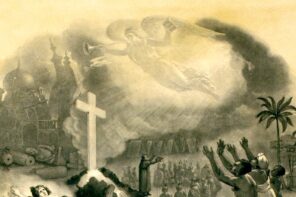When the preeminent historian, Ainslie Embree, died last week at age 96, he was lauded for his contributions to our understanding of South Asian history and politics, but what was often overlooked was what he offered to the study of religion. Arguably it was Embree who helped to launch programs in the study of South Asian religious culture in the United States, and who first recognized the seriousness of the secular-religious split in South Asian nationalism.
He came by the study of religion naturally. A Canadian pacifist who somehow got swept up in World War II as an air force navigator, he then turned to religion at Union Theological Seminary, New York. Afterwards, in 1947, he accepted an assignment from the United Church of Canada to go to India where he and his wife taught at Indore Christian College. On returning to New York in 1957 he completed a PhD in history at Columbia University. It remained his academic home for most of the rest of his rich career as a professor, dean, department chair, and member of the US diplomatic service in Delhi.
Columbia had created a Western Civilization requirement and Embree, along with the China expert Theodore deBary, were determined to make it a global civilization requirement. Embree created the textbook, Sources of Indian Tradition, that became standard for courses in Hinduism and South Asian Islam. He also helped to establish the South Asian Institute, an early model for the new research field of South Asian Studies throughout the Western world. It is hard to imagine now how novel it was then, this idea of studying cultural regions, especially seemingly arcane ones like Asia. But Embree was a pioneer.
He also forged new paths in the study of religion and nationalism long before the rest of the academic community realized how important this topic would become. In a remarkable book of essays, Utopias in Conflict: Religion and Nationalism in India (University of California Press, 1990), Embree showed how secular and religious visions of the Indian nation were fundamentally in competition, though he understood that the religious versions had their own political motivations.
In a separate essay, he ruminated over the partition of India in 1948 and the creation of Pakistan. Though ostensibly an attempt to keep Muslim and Hindu communities separate, Embree thought that issue was never about religious identity but about religious politics, the aspiration of competing political leaders, and wondered how history might have been different if the British had not conceived the issue in communal religious terms.
The case of South Asia, Embree thought, was a good example of why politics and religion should never mix. Like the theologian Reinhold Niebuhr, with whom he had studied at Union Seminary, Embree thought that religion did much to enrich the culture and vitality of a national community, but not its politics, where it could be misused in the hands of ambitious politicians.
Like Niebuhr, Embree was a realist in seeing that the “sublime madness” of the religious vision could be not only an inspiration for greatness but also a tool for venal political aspirations.





